Art Collectors
‘If It Doesn’t Have Psyche, It Can’t Be Art’: Mega-Collector Dakis Joannou Docks His Famous Yacht to Talk About Collecting in a Chaotic Art World
We caught up with Joannou aboard his Jeff Koons-painted superyacht in Hydra.
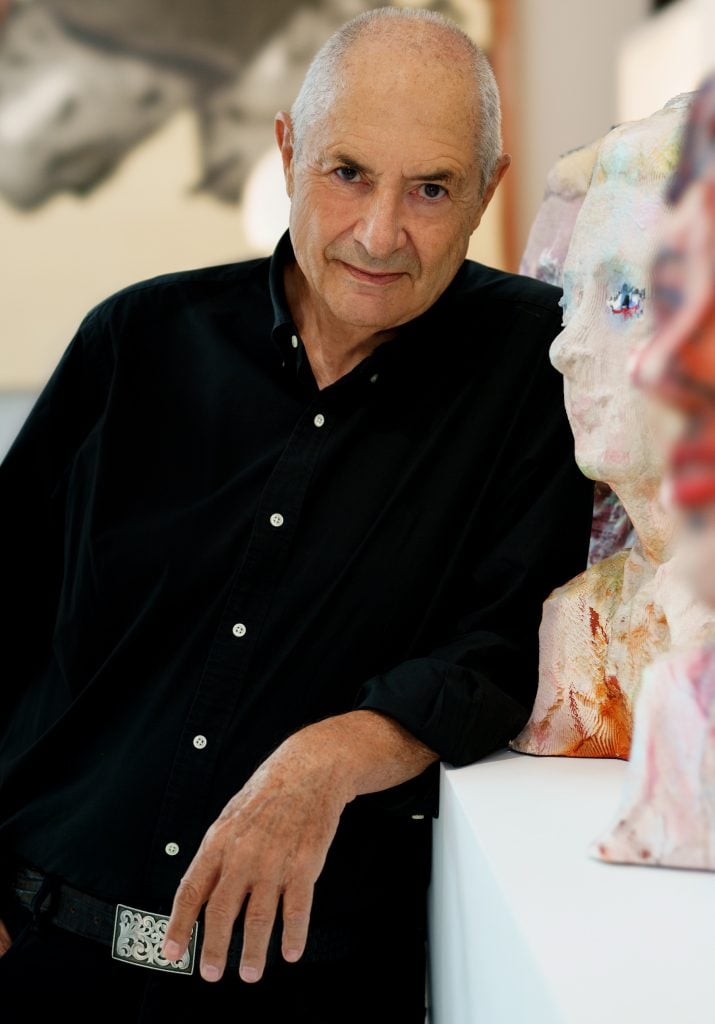
We caught up with Joannou aboard his Jeff Koons-painted superyacht in Hydra.

Naomi Rea

When you roll into port on the Greek island of Hydra—whether that’s on a sumptuous private vessel or a less glamorous public ferry—there’s no missing the Guilty.
The colorful, Ivana Porfiri-designed superyacht has been painted by Jeff Koons in the style of early-20th century dazzle camouflage. The patterns were originally intended to throw off the telescopic vision of German U-boats during World War I, but these jagged lines and geometric swatches of yellow, pink and blue now signal, ostentatiously, the presence in any given port of the billionaire Greek Cypriot industrialist, art collector, and hotelier Dakis Joannou.
A certain sphere of the art world congregates on this Saronic island in the early days of summer, where the 83-year-old collector’s Deste Foundation habitually invites one of the star artists from his collection to show at his project space, situated in a former slaughterhouse on the hillside.
Those in Joannou’s orbit radiate a certain flavor of art-world machismo; he’s tight with artist-provocateurs and market heavyweights Jeff Koons, Maurizio Cattelan, and George Condo—plenty of whose works reside in his collection of some 1,500 objects—or former auction rainmaker Loic Gouzer, and opinionated multi-hyphenates like Kenny Schachter.
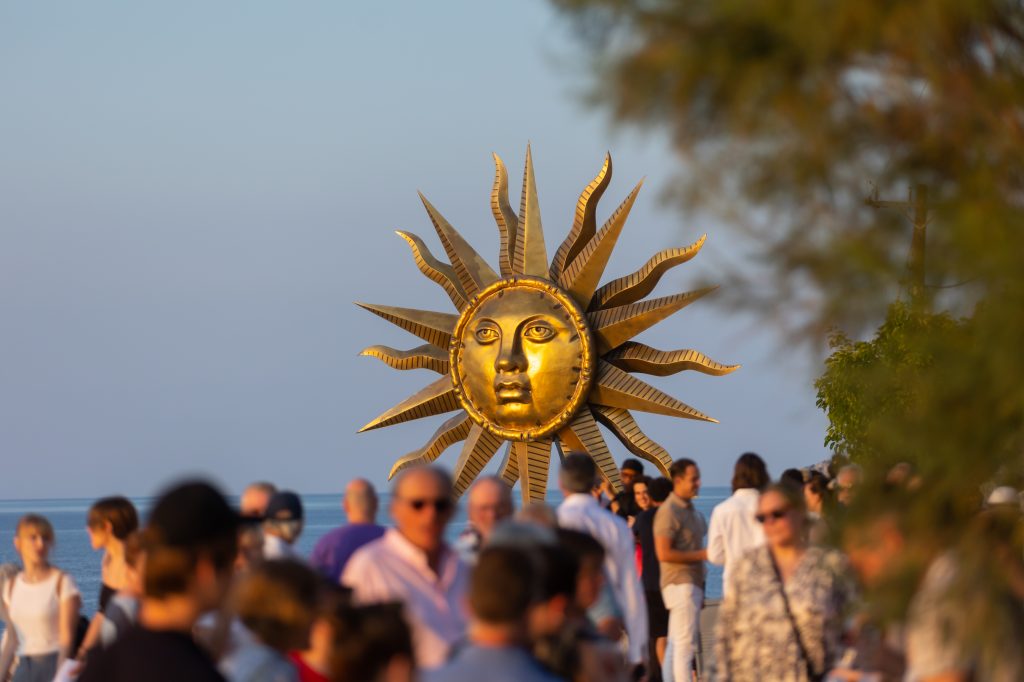
Jeff Koons, Apollo Windspinner (2020–22). ©Jeff Koons. Installation view, “Dream Machines” at Deste Foundation Project Space, Slaughterhouse, Hydra (June 20–Oct. 30, 2023) Photo: Pinelopi Gerasimou.
This year, Joannou hosted a group show co-curated by two former Venice Biennale artistic directors, Daniel Birnbaum and Massimiliano Gioni. The sight of the latter, sweating astride a bicycle powering the show’s electricity, greeted a meandering lineup of art world pilgrims climbing the mountain before sundown. “He’s like the Fabio of the art world,” I heard a conspiratorial whisper behind me, nodding to the fact that Gioni’s crisp white shirt had turned translucent. I didn’t recognize the speaker, but in the snaking procession beneath Koons’s towering “lawn ornament”—his own words to describe his hulking wind-spinner in the shape of a sun—I spotted artists Andro Wekua and Doug Aitken, the Austrian gallerist Thaddaeus Ropac, and art-world-adjacents including James Franco.
If the raw masculinity was getting a little too much, the scenes inside of the slaughterhouse show were refreshingly post-gender. Titled “Dream Machines,” Brion Gysin’s legendary 1960s invention was a highlight among the works responding to the impact of technology on human imagination, as was Wekua’s twitching androgynous cyborg, South Korean rising star Mire Lee’s soft tentacled concrete mixer, and Pamela Rosenkranz’s beguiling robot snake.
Curious to meet the mind assembling this collection, I braved the gangplank of the Guilty to catch up with Joannou about trading ideas with artists, the distortion of Picasso’s legacy, and the thrills of betting on artist futures.
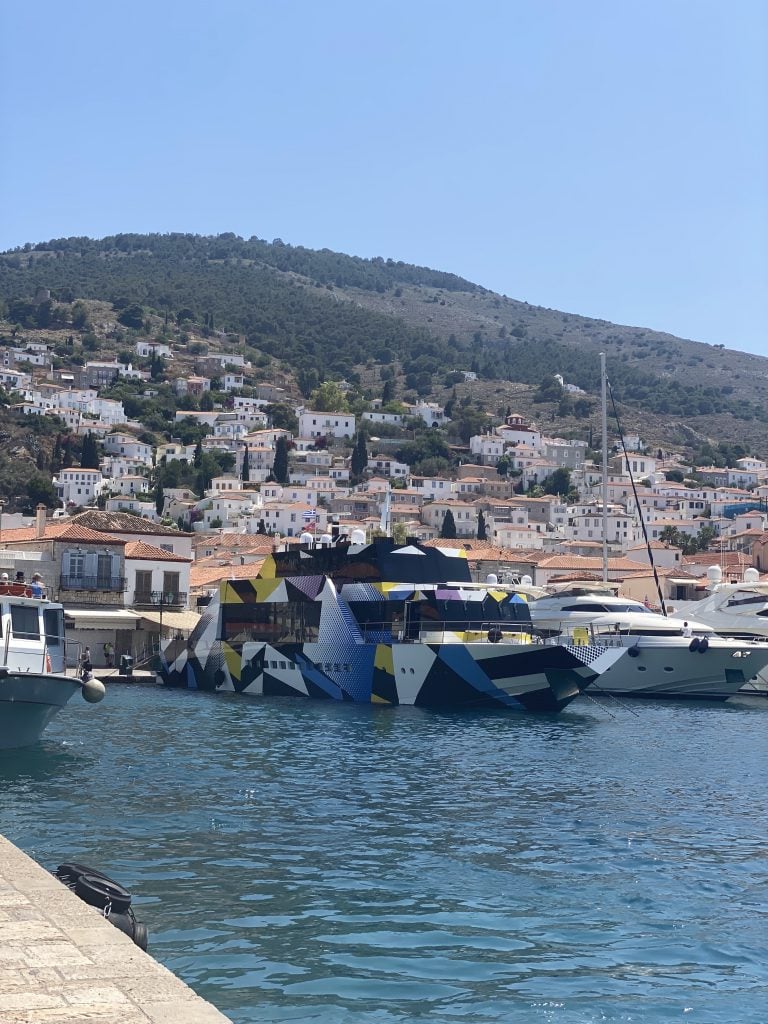
The Guilty docked in Hydra’s port. Photo by Naomi Rea.
Thanks for having me aboard. I’m fascinated with seafaring art in general, and this is pretty much the ultimate nautical artwork. How did this all come about?
It started with Ivana Porfiri, the architect. I asked her to design a boat exactly the way we wanted, the specific length, the kind of shape that we wanted, really wide so that you have this kind of transparency, and completely flat, like a sailing boat, so you don’t have the steps going up like you usually do. So, we found the design of an existing yacht and we cut it horizontally, and then started building up the areas that we wanted. You’ll notice the captain is on this level; normally he should be higher, but higher up it’s our bedroom, and so on. At the end it ended up looking almost like a container transport ship, and Ivana shaped it a little bit.
Being in Greece I guess you have a lot of container ships around.
Yes, but obviously I didn’t want it to look like a container ship. That would not be ideal.
That’s where Jeff’s razzle dazzle comes in?
When Jeff was having a holiday in Hydra, here, I showed him the plans and said, “You have any ideas about how to paint the outside?” So, without hesitation he told me about razzle dazzle. I didn’t know at the time what it was. After I went to the Internet and found out, I said, “Ok, great idea, we’ll tell Ivana.” Then I meet with Ivana, I tell her, “I spoke with Jeff and he has some ideas about painting the boat.” She opens her file, she had the same idea. “I wanted to bring this up to you softly, not to shock you,” she said.
So, I said, “You’re both geniuses, you came to the same idea independently, it’s got to be right.”
I suppose the dazzle has a different effect today than the original purpose of the design.
In fact, some friends of mine in Mykonos saw us once from up high at their house, we were going very slowly, so there was no wake, and they were not sure if were coming or going, they couldn’t tell. So, it’s still successful.
Looking around us at some of the artworks, I’m curious about the decision making process behind what artworks you bring on the boat.
I don’t bring artworks onto the boat. The artworks on the boat are designed for the boat and they stay here. And actually the original help I got was from Cecilia Alemani, the wife of Massimiliano, we are very close friends. So, while it was still in the shipyard, we had David Shrigley come and paint the guest rooms downstairs, Martin Creed did our room, upstairs. Here we used to have a Kapoor mirror, and a Campana Brothers low sofa, but nobody could sit on it. So, we rearranged it a bit, and now we have Urs Fischer.

Ashley Bickerton, Ocean Chunk: Indian Ocean/Aegean Sea (2021). Courtesy Dakis Joannou.
You also welcomed guests to your home in Athens earlier this week. You rehang your permanent collection every year?
I’ll tell you about this installation. It’s about 40 years now since ’85 when I started the collection, and I thought of doing an installation of artists from that time who are not well-known now. I mean it wasn’t about Jeff Koons or Charlie Ray, it was about Ashley Bickerton, Peter Halley, David Salle, Peter Nagy. But it looked to me quite dry, so I decided to start painting some walls, put some carpet down, and add some contemporary works, as well, to put them in the dialogue. So, the whole thing became much more vibrant.
You brought up Ashley Bickerton. His work has a significant place, I know, in the collection, and specifically at home you had some great examples of many phases from his career.
Yes, he was a very close friend up until the end, when he died. We saw him in Bali recently, he came to Greece a couple of times. We saw each other mostly in New York, but we kept a close friendship with Ashley, although he left very early for Bali, in the mid-’90s, I think.
Your daughter Maria’s artworks also have pride of place hanging in your home. Was she influenced or intimidated being surrounded by so many great artists?
She studied painting, but then she got married very early, she had a child very early, and she stopped. And during Covid she started painting again and she took it very seriously and she wants to develop her work.
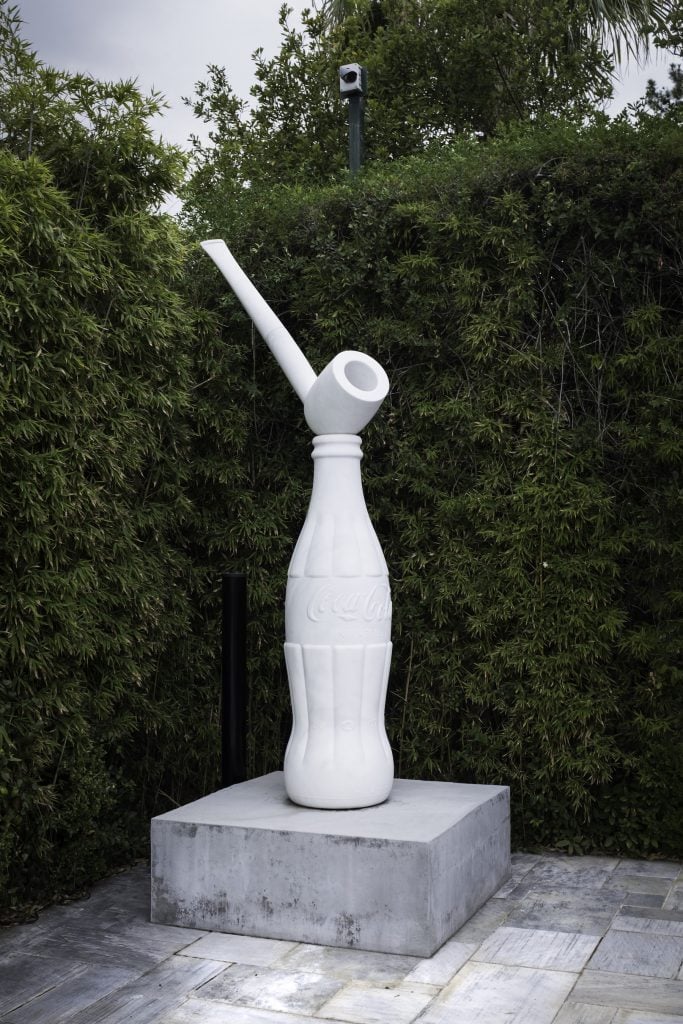
Dakis Joannou, 1965/2015 (2015). Photo: Alexia Antsakli www.artflyer.net
I noticed some artworks that you authored—the Coke bottle pipe sculpture—so at one time you were making art yourself?
Yes, just fooling around, not seriously doing art. I had some drawings, I did that Coke bottle, that I was smoking actually, literally smoking it. And I took my most expensive pipe, a straight-grain Dunhill, which I painted, so inside is really a very precious object, it’s not just a cheap pipe. And then I did the sculpture about six or seven years ago, with Maurizio [Cattelan], he made plans for us to visit the Michelangelo quarries, what do they call them?
The Carrara marble ones?
I saw a huge study of David there, I asked, “What is this?” The guy said, “If we have some more to sell, we do a David.” I said, “How much would it cost to make that sculpture?” “About $100,000.” I said, “How about a piece like my height? A Coke bottle my height?” And then showed him a little picture. “Maybe $20,000.” I said, “OK, let’s go.”
And since then have you dabbled more with making art, or have you left it to the artists?
During Covid I did some drawings, and made some jewelry for my wife, Lietta. Fooling around like this, just playing around, nothing serious.
I see there’s excitement in your eyes when you’re talking about this fooling around, you have a passion for it.
Yes, but I know I’m not talented to be an artist and I don’t have the commitment to being an artist, so I’m not, I never attempted to be one.
But having so many artist friends and the means to support them, I’m sure enables a lot of work to be made that wouldn’t otherwise have been made?
I’m not supporting any artists, that’s not the right term for me, at least. I’m familiar with the artists, I buy their work from their galleries and when we get together we talk about maybe art, maybe gossip, or our families, or gathering ideas. So, that’s a different kind of relationship I have with them, it’s not like a collector supporting an artist.
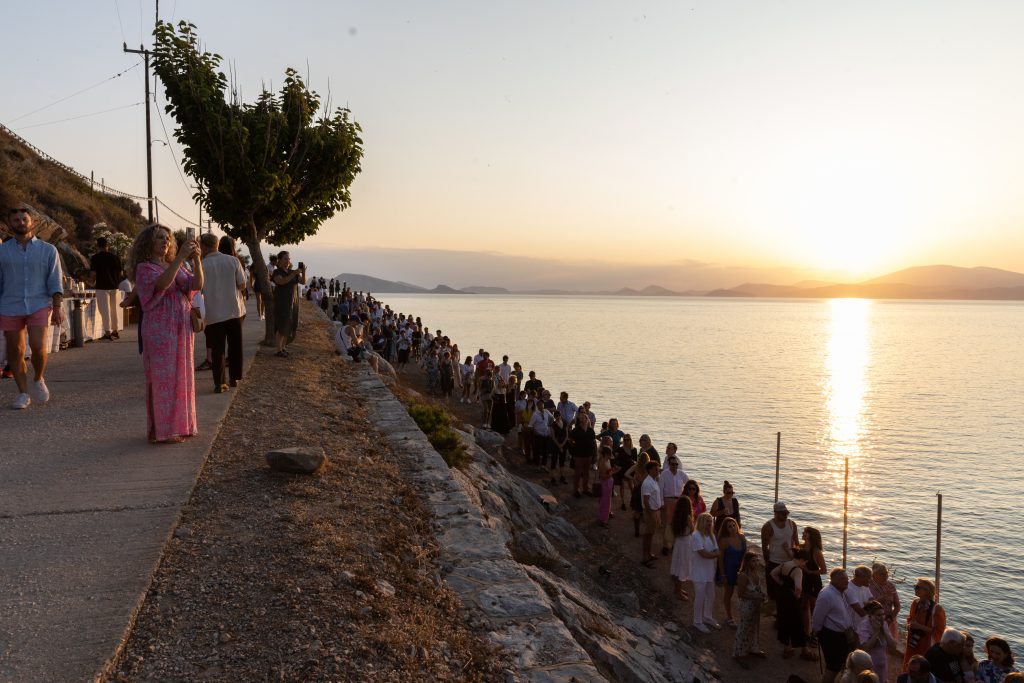
View from the opening of “Dream Machines” at Deste Foundation Project Space, Slaughterhouse, Hydra (June 20–Oct. 30, 2023) Photo by Pinelopi Gerasimou.
So, you don’t really see yourself as a patron or enabler of the arts in that kind of way?
No, not at all. No, and in fact the Hydra project is an example. The budget’s extremely limited; I mean ridiculous. I wouldn’t like to quote the number, but the number is ridiculously low. So, I invite these mid-career artists and give them a challenge, with this budget, and they can choose either to stay within the budget or get their galleries to support it, or do it themselves. And that’s why I never asked Jeff [Koons] for 10 years to do anything. And then we just happened to talk about it and I told him, “I didn’t tell you because our budget is not enough for your morning coffee!” He said, “I’ll do it,” so I said, “OK, but here’s the budget.”
I think Jeff Koons may be an exception in that not a lot of artists make work the way he does or to the degrees of perfection that he requires. Has your friendship with him ever helped him over the years to realize some of these projects?
Yes, it has. At the time of “Celebration,” because costs were flying off and the three dealers were pulling out, I made a deal with the dealers, they gave me, in kind, the money I gave them. And then I took over the publication of the “Balloon Dog.” At the time we had some business in L.A., as well, so I was visiting, and I made it myself.
And you don’t see that as support?
Yes, that was an exception. It was a difficult time, it was an exception.
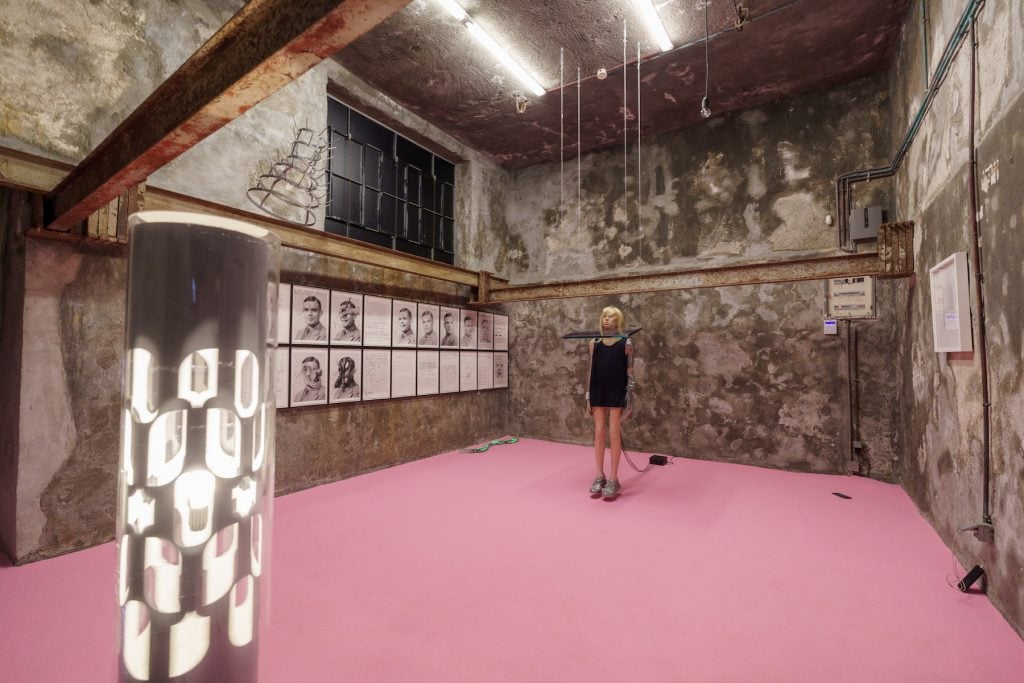
Andro Wekua, Untitled (2014). Installation view, “Dream Machines” at DESTE Foundation Project Space, Slaughterhouse, Hydra (June 20 – Oct. 30, 2023) Photo by George Skordaras.
So, you mentioned the dealers, and we don’t have to talk about Jeff’s dealers specifically, but you’re friends with artists, does that mean you’re also friends with all of their gallerists?
Well, I know the gallerists, I’m close with them, but my real relationship is with the artists, or the curators, or some museum directors. I’m more into the art side rather than the commercial aspect.
We’ve been talking about Jeff Koons. You became a collector after you met him. Do you think Koons is a genius?
He’s beyond genius. Something very, very special. Way beyond normal artists.
There are a lot of people, I think, today who would agree with you on that. But I don’t suppose it was always that way. Is there a point that you can pick out from your memory seeing things click with the wider public the way they did with you?
We have had a very steady friendship, with the family, I was the best man at his first wedding, I christened his first son, and we go on holidays together. I think the “Celebration” series was the one that really opened him up—although even before, even “Luxury and Degradation” and then a couple of other shows that he had before. Because Celebration never had a show actually, never. Which is very weird, a whole body of work without really having a show.
How is that possible?
Because the work was so expensive to produce and the funds were not there. So, it was going very, very slowly and in the meantime Ileana Sonnabend got old, she died, Antonio [Homem, her adopted son] made a little gallery that he couldn’t obviously afford to support with the costs, and Jeff was struggling to finish the work. Even until recently. “Play-Doh” was only finished six or seven years ago. “Balloon Dog” took six years, and the only reason it finished quickly is because there was a show at the Royal Academy in London, he had to finish it to show it there.
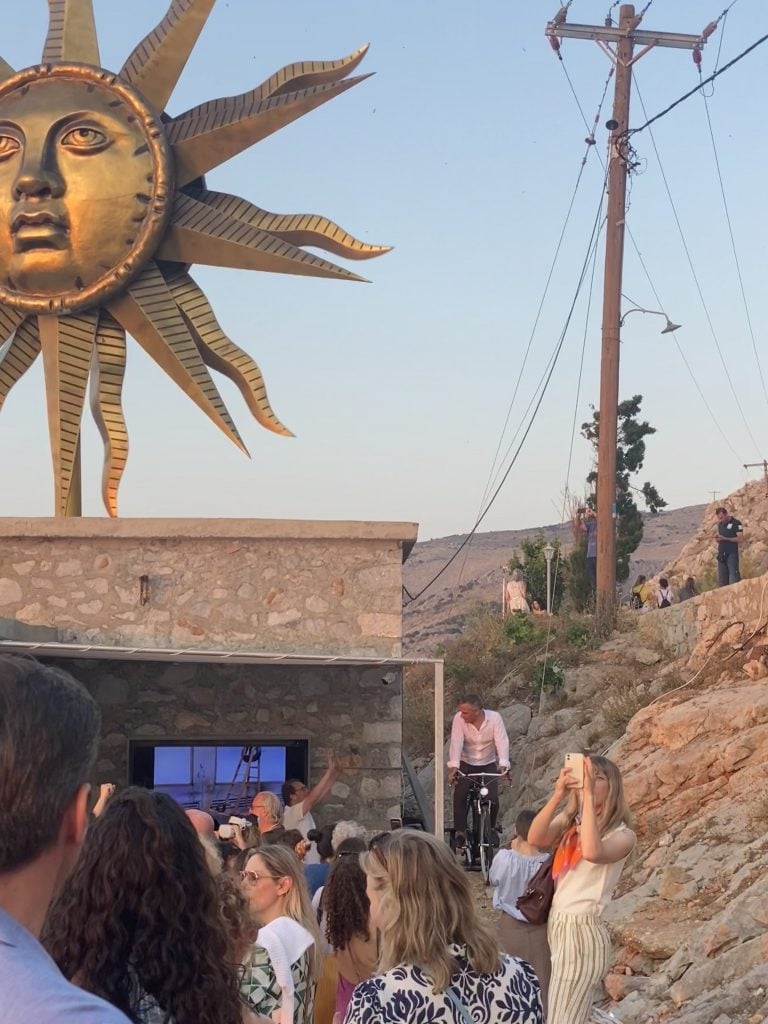
A View from the opening of “Dream Machines” at Deste Foundation Project Space, Slaughterhouse, Hydra (June 20–Oct. 30, 2023) Photo: Naomi Rea.
The show this year at the Slaughterhouse—last year you went from having a star artist as the focus and this year you have two star curators. What led you in that direction?
Quite simple, actually. I felt that the dominance of Jeff Koons’s wind spinner would have been too much for an artist to come right after. Even the celebration we will have today when we hand it over to the city, if there was another artist in the show it would have been kind of odd, I felt. So, I decided this year for really the first time, instead of having one artist, to do a curated show. Next year it will be George Condo. So, he’s cool and he doesn’t worry about that. He doesn’t have a problem.
You have a George Condo portrait at home. How did that come about?
Well, he had a show in Luhring Augustine at the time and we visited the show with Maurizio, the two of us, and he said, “Why don’t you ask George to make you a portrait?” I said, “Why don’t I ask him to make a portrait of the two of us?” So, we called Roland [Augustine] and he calls George up, and said, “When can you meet with Dakis and Maurizio to discuss about doing a project together?” He said, “Right now.” So we called a taxi to go uptown, we sat down, had a discussion. Afterwards we said, “OK, when are we going to start?” He said, “Right now.” I said, “What do you mean? I have a meeting in half an hour.” He said, “No, plenty of time, don’t worry.” So, he takes a painting of a landscape, it was the sea and something else. He turns it portrait, horizontal, and in half an hour he did a great painting.
He said, “That’s not the painting, that’s my study for the painting, the painting will come later.” So, it took him about a year and he did two paintings. So, it’s like three copies, the original one, that is painted very roughly. And two more that are really very well thought out.
And you have a Condo sculpture too, a head sculpture at home?
Yes, of me and Lietta, but he did Lietta like an idea, not like a person.
You own a number of portraits of yourself, or works that respond to you in some way. Is that something that you ask for?
No. I mean, again, it happens, I told you about George, and after that, he said, how about doing a sculpture of me and Lietta, it just came naturally.
For Roberto Cuoghi, I was trying to get a work of his and it was almost impossible, he was producing two works a year. So, when I met him, I said, “How can I get a work from you?” “Very easy,” he said, “I’ll do you a portrait.” So, it was his initiative, you know? So, somewhat like this.
Urs Fischer, Massimiliano asked him to do something for the Greek Gift, he said, “I’ll do a portrait of Dakis and Lietta.” He couldn’t do it in six months. It was a year later.
You can’t rush art.
Yes, but he did a good job, I think. Because obviously he knows our relationship very well and is very close, to both of us. He expressed the relationship with that, he very carefully chose his moments.
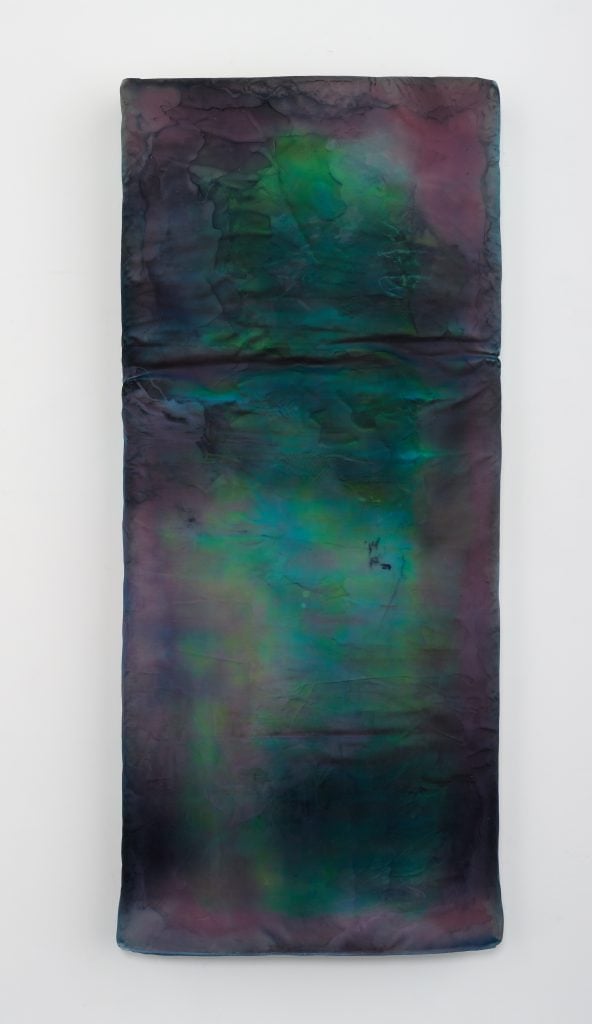
Kaari Upson, Death Bed (2016). Courtesy Dakis Joannou.
Do your relationships with artists mean that you are sometimes involved in the genesis of their ideas?
Well, we develop these family situations. Take Kaari Upson. We met her and became very close, and I’ve got a lot of her work. Unfortunately we lost her very early.
We were having lunch once at Cipriani with Kaari, Maurizio, and myself. And Maurizio kept pressing Kaari to do a small “mattress” for him. And Kaari said, “I’m done with mattresses, I’m not going to do any more mattresses.” In the meantime I had two or three of them, so I said, “Listen, Kaari, I have an idea. I have two, the single and the married ones,” I said, “Let’s do the circle of life. So give me a baby cot,” which I didn’t have, “and do a bed for Maurizio, and a death bed.” She said: “OK, I’ll do that but then that’s it.” And she told me how she struggled with the death bed, because she was ill, and she knew that maybe she wouldn’t survive.
I’m fascinated by that, also by artists who exchange works with each other. Is that how you prefer to edit when works no longer fit in the collection?
No, I sell them. It’s no sin.
Definitely not a sin, but the market, obviously it’s a complicated place. Do you take works back to the dealers or to auction?
Either/or, whatever, but it doesn’t happen so often.
Because you love the works too much?
Yes, I mean there are some works I cannot sell now. The artist never got anywhere, some even stopped being artists. We all make mistakes.
Do you see an artist’s work not rising in value as a mistake?
No, it’s not about value, it’s about the quality of the work and about the artist himself or herself, their career. At some point you see them just going downhill, not in terms of the market, in terms of imagination, productivity. I mean someone like Urs Fischer, every day he has a new idea. Or sometimes you might get stuck with an idea and it doesn’t really move from that. But back when I was collecting very early, my friend David Teiger, the collector, he told me good advice. He said, “Dakis, you are getting on the plane when they are still on the runway. Wait until they get to about 10,000 feet. Not to 20,000, but 10,000 feet, just watch them a while.” And he was right.
You have got many brilliant artists in your collection who definitely aren’t at 10,000 feet, they’re a lot higher now.
They’re in the stratosphere now.
And are you still coming in at the 10,000 feet?
Not at the 10,000 feet, but at the 30,000 feet, yes. Or like Kaari, maybe she was at 20,000 feet when I started buying her work.
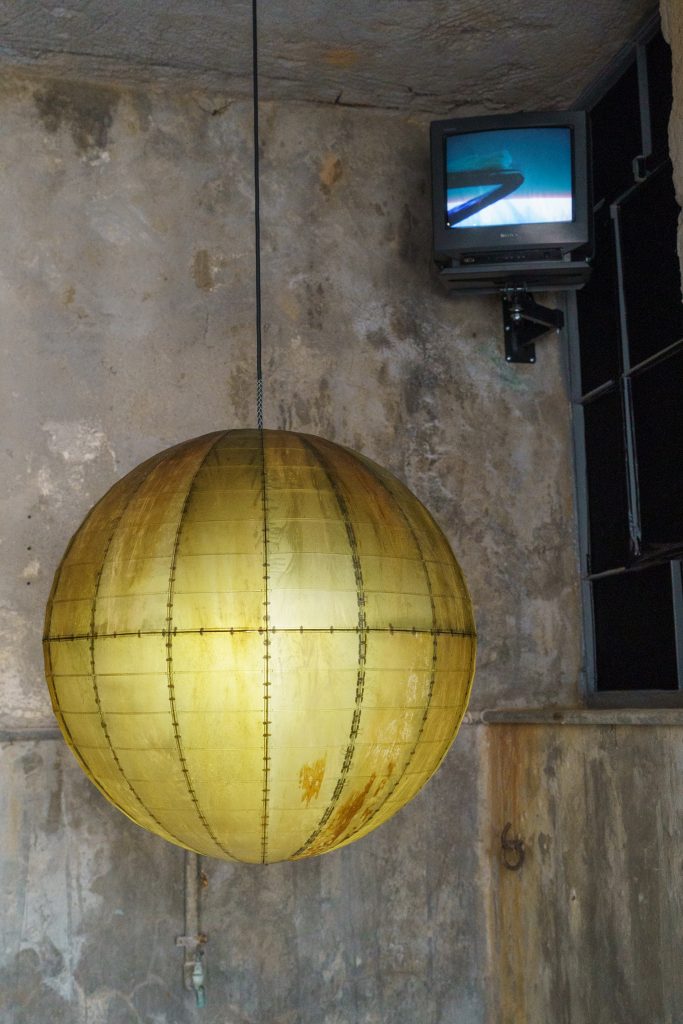
Anicka Yi. Installation view, “Dream Machines” at Deste Foundation Project Space, Slaughterhouse, Hydra (June 20–Oct. 30, 2023) Photo: George Skordaras.
I’ve just come from Art Basel, and one conversation a lot of people were having was about how the prices for living artists have gotten too high. Would you agree?
I really cannot tolerate the present art scene. I have no understanding, I’m not good with it, I’m old school. I mean before there was a show with an artist, you would have 10 to 12 paintings, then they selected people to work with and they would send you the slides to choose. Now there is a show of an artist, a PDF comes with maybe 40 to 50 artworks to choose from. It’s overwhelming.
There have been a lot of shifting social mores and ideas in the time that you’ve been collecting and recently a lot of conversations about things like reviewing Picasso’s work in light of what people think of how he lived his life.
It’s stupid, I can’t believe this nonsense. Like judging 3,000 years ago the Greeks that were doing something we don’t do today? They had slaves. What can we do now? At that time it was normal to have slaves and slaves were not involuntary. So, that’s it, that’s how it worked, so what can we do now? 50 years ago, 100 years ago, 60 years ago when Picasso was still alive and being criticized, this kind of gender thing was normal. Even at my age, not Picasso’s age. Up until 20 years ago it was almost normal. So are we going to judge the character of Picasso now? Who are we to judge his character? What right do we have to judge him? We don’t have any right. He lived his life, he was a successful artist, he died, the wives or affairs or children he had, everybody’s happy now. So, what’s the problem? Just leave Picasso alone.
That’s one take on Picasso’s legacy. But I want to bring us back a little bit to yours. You’ve got a lot of work in the exhibition that’s responding to this alarming technological disruption that we’re living through. How do you engage with this?
Well, we have touched on it in the show, and this morning I had a very interesting discussion about using these new advances in technology or artificial intelligence. Because the collection is the tool, but my legacy, what I want to be remembered for, is the Deste activity. And we were talking to a guy from California and he had some very interesting ideas. He asked how to present the history of Deste, and make it interactive. So people can go into a virtual version of the show, maybe they will add an artist or take away an artist if they do not feel it fits or adjust the exhibition, and then repost it.
That is the first meeting we had, I’m not an expert on that, but he had some really interesting ideas about that. So, he said, “Your site should remain active, it’s not about going back and always searching what Deste did.” Deste would stay alive through using artificial intelligence and through using all these tools that we have now to engage people. So, now if we manage to do it, it will be fantastic.
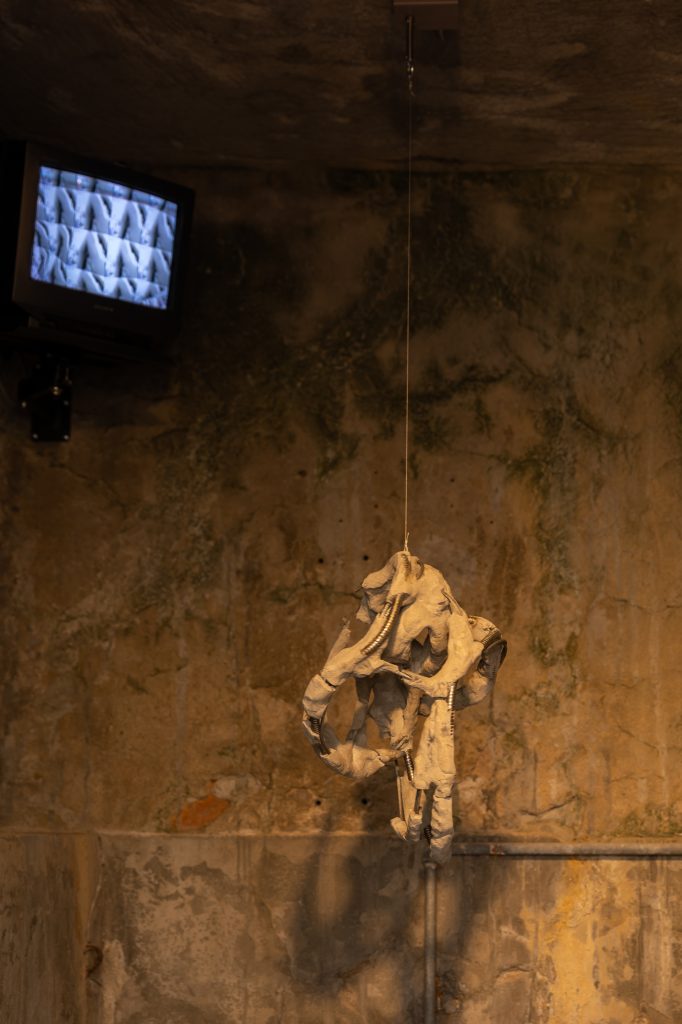
Mire Lee. Installation view, “Dream Machines” at Deste Foundation Project Space, Slaughterhouse, Hydra (June 20–Oct. 30, 2023) Photo: Pinelopi Gerasimou.
Another tech-related question. I noticed your geolocated Lee Bul AR work, which was very interesting to see imposed over the horizon yesterday, is also an NFT. And I know that Urs Fisher, as well, is making NFTs. Is that part of the collection?
I’ve got one NFT, the first one, but that’s it. The CHAOS one, the egg and the lighter.
Did he have to work hard to sell it to you? To the concept?
No, I bought it through Loic Gouzer.
What is your take on the boom and bust that happened with NFTs?
Yes, I paid a hell of a lot of money for it, for what it’s worth now. It’s OK, it’s just a piece.
And do you think that the NFT technology has a place in the future of art?
I don’t know how it’s going to develop, it’s hard to tell. I’m not sure, because from what I see all these people that use artificial intelligence, like this guy now at MoMA, Refik [Anadol]…He caught all the data from the MoMA collection. I just can’t see the connection with how can I call that piece art? I mean it’s really interesting, very fancy, but is it art? I’m not sure, maybe it is, maybe it isn’t.
I suppose digital art, like any other medium, can be of varying qualities.
Yes, but not just the quality, it’s also if it has psyche in it or not. It may look beautiful and so on, but if it doesn’t have psyche it cannot be art.
Finally, I wanted to ask you: What advice would you give to somebody starting out collecting today? Even if they have not really a huge amount of means?
Well, I think it’s: go slow, go with your heart, and your mind, and your pocket. Combine those three and then you will take small steps and you’ll get there.